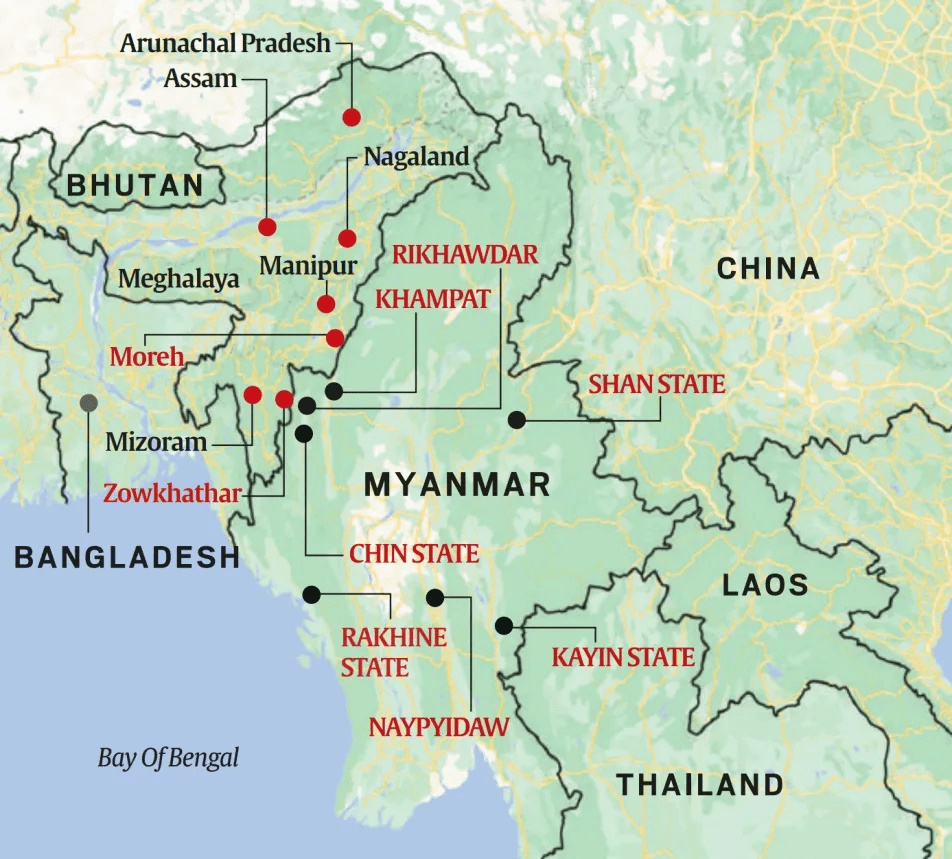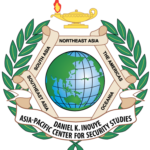The ongoing internal conflict in Myanmar is not just an isolated struggle; its ripple effects are fueling long-term ethnic tensions in Manipur, India. The political instability, armed resistance, and humanitarian crisis unfolding across Myanmar’s western states—particularly in Chin, Kachin, and Shan—are directly linked to the ethnic conflict in Manipur. As Myanmar remains embroiled in a civil war against the ruling Tatmadaw military junta, the conflict’s transnational impact continues to exacerbate the already fragile ethnic dynamics in India’s northeastern states. This interconnected security challenge requires a nuanced, multi-faceted, and conscious response from New Delhi, recognizing the unique circumstances faced by each border state.
Manipur: The Epicenter of Spillover Effects
Although the India-Myanmar border spans 1,100 miles with three key northeastern states—Nagaland, Manipur, and Mizoram—the Myanmar conflict disproportionately affects Manipur’s security environment. Unlike Nagaland and Mizoram, where cross-border ethnic kinship exists but is less volatile, Manipur is experiencing an intensified security crisis due to the deep ethnic linkages between Myanmar’s western provinces and Manipur’s Kuki-Zo and Meitei communities. The Free Movement Regime (FMR), which historically allowed unrestricted cross-border movement, has facilitated the movement of refugees, armed militants, and illicit trafficking networks.[1] This has further complicated Manipur’s existing ethnic strife as armed groups leverage the border to regroup, reinforce, and retaliate against rival factions.[2]
The ongoing clashes between the Kuki-Zo and Meitei communities in Manipur mirror the broader ethnic divisions in Myanmar, making the situation even more volatile.[3] Cross-border kinship ties have led to the direct involvement of armed factions on both sides, escalating violence within Manipur.[4] The porous border has also enabled the influx of weapons and narcotics from Myanmar, aggravating security concerns for India. Given Manipur’s unique geographic and ethnic context, the Myanmar conflict catalyzes and prolongs the extreme internal instability in the state.[5]
Delhi’s Geopolitical Lens: Managing Ethnic Conflict, Trafficking, and Countering China
India’s approach to the Myanmar conflict is mainly because it is concerned over ethnic conflict in Manipur, illicit trafficking, and geopolitical competition with China. The Indian government perceives Myanmar’s instability as a direct contributor to Manipur’s deteriorating law and order situation, leading to proposals for tightening border security, including restrictions on the Free Movement Regime (FMR) and a renewed focus on border fencing.[6] The influx of refugees and militants into Manipur has fueled concerns over human trafficking and the expansion of transnational criminal networks, including drug smuggling operations linked to Myanmar’s Golden Triangle region.[7]
Beyond immediate security concerns, India’s strategic calculus also considers China’s role in the region. Beijing’s engagement with Myanmar’s military junta, as well as its growing influence in Myanmar’s infrastructure and resource sectors, raises alarms in New Delhi.[8] India fears that China is leveraging the instability in Manipur as a means to weaken India’s influence in the northeast and consolidate its foothold in Myanmar.[9] By ensuring Myanmar remains dependent on Chinese economic and military assistance, Beijing indirectly exerts pressure on India’s northeastern states, complicating New Delhi’s regional security strategy.
India Needs a Diversified Policy Approach
Given the varied impact of the Myanmar conflict on Nagaland, Manipur, and Mizoram, India cannot pursue an overall general policy towards the region. Each border state faces distinct security and political challenges, necessitating a diverse political toolkit to manage the evolving crisis effectively.
- Manipur requires a strong security-centric approach that includes tighter border controls, enhanced intelligence-sharing, and proactive measures to curb arms and drug trafficking. However, this must be balanced with humanitarian considerations, ensuring that legitimate asylum seekers and displaced populations receive appropriate support without exacerbating local ethnic tensions.
- Nagaland’s policy focus should emphasize diplomatic engagement and cross-border ethnic integration efforts, as the region has not experienced a spillover like Manipur. Still, the Nagas (an ethnic group that predominately lives in the northeastern state of Nagaland in India) have been agitating for more autonomy.
- Mizoram, traditionally more receptive to refugees from Myanmar’s Chin state, needs a policy integrating humanitarian aid with community resilience-building measures.[10]
New Delhi must also engage with regional and international stakeholders to stabilize Myanmar, recognizing that a prolonged civil war there will continue to have destabilizing effects on India’s northeastern states. Without a comprehensive strategy that integrates security, diplomacy, and economic development, the interconnected crises of Manipur and Myanmar will persist, threatening broader regional stability.
The internal conflict in Myanmar is inextricably linked to the ethnic unrest in Manipur, making it imperative for India to adopt a nuanced and adaptive policy approach. While Myanmar’s instability affects all three Border States—Nagaland, Manipur, and Mizoram—Manipur remains the most impacted, requiring urgent attention from New Delhi. India’s policy response must not only address immediate security threats such as trafficking and cross-border militancy but also counter China’s strategic maneuvering in the region. A one-size-fits-all approach will not suffice; instead, India must deploy politically nuanced strategies to address the unique challenges faced by each state while working toward broader regional stability.
The author would like to thank Dr. Miemie Winn Byrd, Professor DKI APCSS, for her expert comments and careful review of the previous versions of this paper.
The author also benefited from several conversations and interviews in India about the situation in the northeastern states of India and the adjoining Myanmar civil war.
The views expressed in this article are those of the author and do not reflect the official policy or position of DKI APCSS, the Department of Defense, or the U.S. Government. The appearance of external hyperlinks does not constitute endorsement by the United States Department of Defense (DoD) of the linked websites, or the information, products, or services contained therein. DoD does not exercise any editorial, security, or other control over the information you may find at these sites.
[1] Pushpita Das, “Free Movement Regime: A Unique Feature of the India-Myanmar Border,” IDSA Comments, January 17, 2024.
[2] Mukesh Ranjan, “After scrapping FMR, Centre brings in new system for movement across India-Myanmar border,” The New Indian Express, December 28, 2024.
[3] Praveen Donthi, “Ethnic Clashes Roiling Manipur Pose Test for India’s Modi,” International Crisis Group, July 26, 2023.
[4] Anshuman Behera, “The Social and Political Dimensions of Ethnic Conflicts in Manipur,” Observer Research Foundation, November 11, 2023.
[5] Regalado et al., “From India to Australia, Myanmar is flooding Asia with cheap meth,” Nikkei Asia, March 29, 2024.
[6] Sanjay Pulipaka, “Political instability in Myanmar and the resulting refugee influx are straining Northeast India’s security,” The Hindu, February 20, 2025.
[7] Santishree D. Pandit, “Northeast in the middle of a narco-terror crisis,” Sunday Guardian Live, January 5, 2025.
[8] James Palmer, “Is China Playing Both Sides in Myanmar?” Foreign Policy, January 9, 2024.
[9] Gunjan Singh, “How China and India view growing unrest in Myanmar,” Deccan Herald, September 4, 2024.
[10] Rodingliana, “Why are the Mizo people helping the Chin refugees in their state?” Indian Development Review, September 2, 2024.
Published: March 31, 2025
Category: Perspectives
Volume: 26 - 2025
Author: Srini Sitaraman






